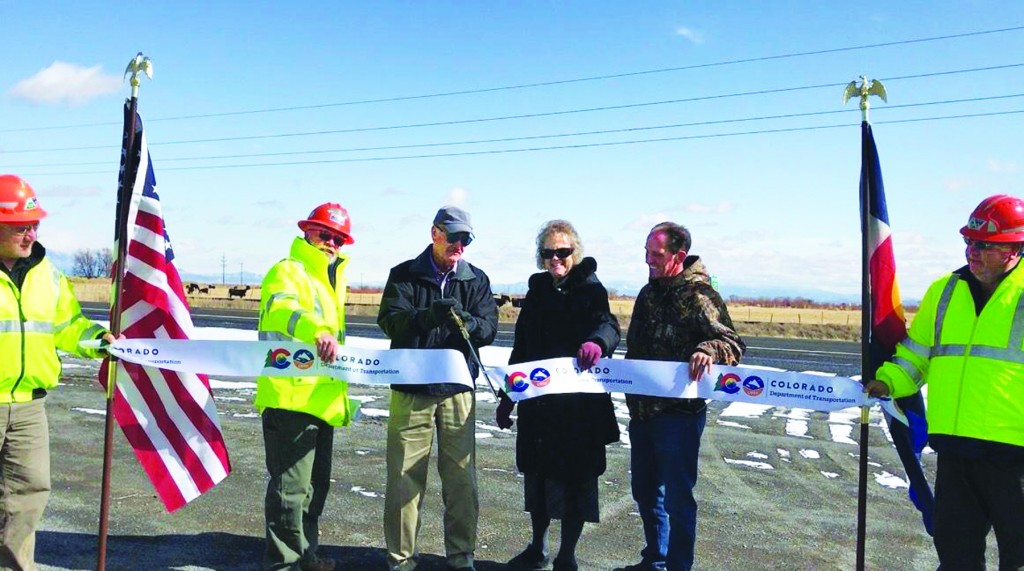SLV completes three road projects

CONEJOS COUNTY — Highway work is common in the summer months and irritation among motorists is equally common, so completion of a major improvement project is something to celebrate.
Ribbon cutting for completion of a highway project in three San Luis Valley counties Wednesday offered the crew that worked on it and officials of the counties affected an opportunity to celebrate. The same pull-out that had served as an unofficial home base along U.S. 285 about 10 miles south of Alamosa was scene of the ceremony.
The safety and welcome to persons driving on U.S. 285, Colo. 112 and State Highway 159 were emphasized as Kevin Curry, Colorado Department of Transportation(CDOT) program engineer talked about the importance of safety and economic impacts.
“First and foremost, safety is CDOT’s No. 1 priority,” he said. Earlier this year, CDOT announced an initiative and education campaign. The Whole System — Whole Safety initiative.
“It has one simple mission — to get everyone home safely!” Curry said.
According to CDOT information, this initiative heightens safety awareness on every front, “With our employees and contractors and their work on projects like these, as well as focusing on our goal to improve Colorado’s transportation network by reducing crashes and improving the safety of all transportation modes.
ECONOMY
Agricultural and commercial trucking: CDOT realizes San Luis Valley communities rely on these highway corridors for economic growth and development.
Agriculture depends upon safe, passable roads to transport goods and products.
TOURISM
Safe and well maintained roads are important to our tourists who visit the area.
Local attractions including the Great Sand Dunes National Park, all the historic communities and landmarks along the scenic and historic byway of Los Caminos Antiguos and beautiful Sangre de Cristo Mountains.
PROJECTS
OVERVIEW
Resurfacing Colo. 112 involved $4.6 million; APC Southern Construction of Golden was contractor and Project Engineer/Manager was Jason Velasquez of CDOT
Lasting from April through July of 2019, work was done in Alamosa, Rio Grande and Saguache counties and included:
Fourteen miles of improvements from the junction of CO 112 and US Highway 285 at about mile point 13 and continued through the town of Center to the junction of CO 112 and CO 17 at about mile point 28.
This was resurfacing overlay, sign and delineator replacement and new pavement markings
Benefits outlined by CDOT: The work greatly enhanced safety for rural travelers and the local agriculture industry on this two-lane highway and a smoother surface offering safer driving.
SH 159 resurfacing involved $5.9 million in Costilla County and work was done between July and September. Constructor was A&S Construction Co. of Cañon City.
Project Engineer/Manager also was Jason Velasquez of CDOT.
Work included, resurfacing 15 miles of CO 159 from Fort Garland to San Luis, Initial leveling course, work on the railroad crossing south of 3rd Street in Fort Garland, milling and overlay work; new signing and pavement markings. A repaved road reduces damage and repair costs to cars
US 285 Chip Seal from Antonito to Estrella in Conejos County involved $2.4 million. Contractor was Slurry Seal, Inc. of North Salt Lake, Utah and Project Engineer/Manager was Robert Sanchez of YEH & Associates.
Work included, chip sealing and updating the existing signs on US Highway 285 from Antonito to just south of Alamosa at Estrella, about 20 miles from mile point 6.5 to 27.
Chip sealing consists of placing a blended asphalt on the existing pavement, covering it with crushed aggregate, rolling the newly placed chips and sweeping off any excess chips. A week later a thin layer of diluted emulsion is placed on the chips to give the road surface a black top.
This prolongs the life of the asphalt to enhance safety for cars and trucks and new updated signs and paint were installed to help with visibility.
Information was provided by Lisa Schwantes, southwest regional communications manager (Region 5).



